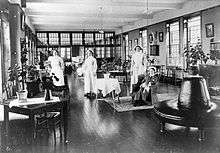Upper Saxondale
| Upper Saxondale | |
 Upper Saxondale |
|
| District | Rushcliffe |
|---|---|
| Shire county | Nottinghamshire |
| Region | East Midlands |
| Country | England |
| Sovereign state | United Kingdom |
| Post town | NOTTINGHAM |
| Postcode district | NG12 |
| Dialling code | 0115 |
| Police | Nottinghamshire |
| Fire | Nottinghamshire |
| Ambulance | East Midlands |
| EU Parliament | East Midlands |
| UK Parliament | Rushcliffe |
|
|
Coordinates: 52°56′42″N 1°00′14″W / 52.945°N 1.004°W
Upper Saxondale is a residential area situated mainly in the parish of Radcliffe on Trent, in the Nottinghamshire borough of Rushcliffe. A section also falls within the parish of Cropwell Butler. Upper Saxondale is located in an upland area set between the River Trent and the Vale of Belvoir and between the A52 road and the A46 road close to their junction at Saxondale Roundabout near Bingham. The nearby hamlet of Saxondale was the site of an Anglo-Saxon fort and earthworks, clearly visible from the A52 road.
Characteristics
Upper Saxondale was developed on the site of the former Saxondale Hospital[1] by David Wilson Homes from approximately 1995 to 2001. The area includes approximately 350 dwellings, ranging from 3 bedroom converted hospital buildings to newly built 5-6 bedroom detached houses. There is also a restaurant-bar called Sanctuary, a hairdresser, tennis club and bowling green. The estate is surrounded by parkland, much of which is owned by Upper Saxondale Residents' Association.[2]
Upper Saxondale is a designated conservation area of 30 hectares. The boundary of this conservation area contains the entire former Saxondale Hospital site and includes extensive semi-wooded grounds, parkland landscape and many fine trees.
The chapel was built in 1902 to the designs of E.W. Roberts, the then County Architect, for use by hospital staff and patients. The small, gothic revival style building is home to Catalyst Church (part of Christian Growth International).
David Wilson Homes originally called the development "St James Park", but the residents voted to change the name to "Upper Saxondale" at a Residents' Association meeting in 1999. Upper Saxondale also includes the original houses on Saxondale Drive, which are not part of the David Wilson Homes development.
Today the site is a blend of old and new. High quality conversions of the Victorian buildings, the mature parkland, its core of community buildings and its public open spaces have resulted in an unusual residential area of special character and quality.
The extremely rare Flame Brocade Moth has been spotted at Upper Saxondale.
There are several ghost stories relating to the history of the area: most notably a troop of Roman soldiers marching up Henson Lane. The ghost of Lady Elinor Denison is said to be haunting the grounds.
King Henry VII is said to have camped on land to the west of Upper Saxondale during the Battle of Stoke Field.
A RAF bomber crashed close to Upper Saxondale during WW2. The site is marked by 5 mature trees set out in the shape of a cross in the middle of a field close to the main Saxondale Drive. The impact made a slight hollow and piles of earth are still clearly visible. The site was originally marked with a memorial stone, although this has now been removed.
Saxondale Hospital

The former Saxondale Hospital was the county asylum for Nottinghamshire, and was used as a military hospital during World War I from August 1918 to October 1919 to care for shell-shocked soldiers.[3] The hospital was built to replace Sneinton Asylum and the foundation stone was laid on 25 July 1899. The new building — designed by architect E. Purnell Hooley, better known as the inventor of Tarmac — was two stories high, cost £147,000 and had accommodation for 452 patients (226 of each sex). The 130 acres (0.53 km2) surrounding the hospital cost £6,800. It was officially opened 24 July 1902 by Lady Elinor Denison. In 1913 extensions were made for 148 patients, which cost £29,833. In 1920, Charlie Chaplin was admitted to Saxondale Hospital suffering from depression. In 1932, two further blocks were erected, each to accommodate 50 female patients. In 1955, two further villas were built, one to accommodate 36 females and the other 36 males. The hospital closed in 1987 and was partly demolished prior to redevelopment.[4] Responding to an allegation of sexual abuse by Jimmy Savile at the hospital, Nottinghamshire Healthcare NHS Trust said it was satisfied that Savile only visited the hospital on one occasion although the outcome of a report into the allegations is expected to be published in June 2014.[5]
References
- ↑ "Saxondale Hospital". County Asylums. Retrieved 2007-08-10.
- ↑ "Upper Saxondale Residents Association". Retrieved 2007-08-10.
- ↑ http://www.1914-1918.net/hospitals_uk.htm . Retrieved 2007-08-10
- ↑ "Index of English and Welsh Lunatic Asylums and Mental Hospitals". Middlesex University. Archived from the original on 2007-07-18. Retrieved 2007-08-10.
- ↑ http://www.bbc.co.uk/news/uk-20985028. Missing or empty
|title=(help)